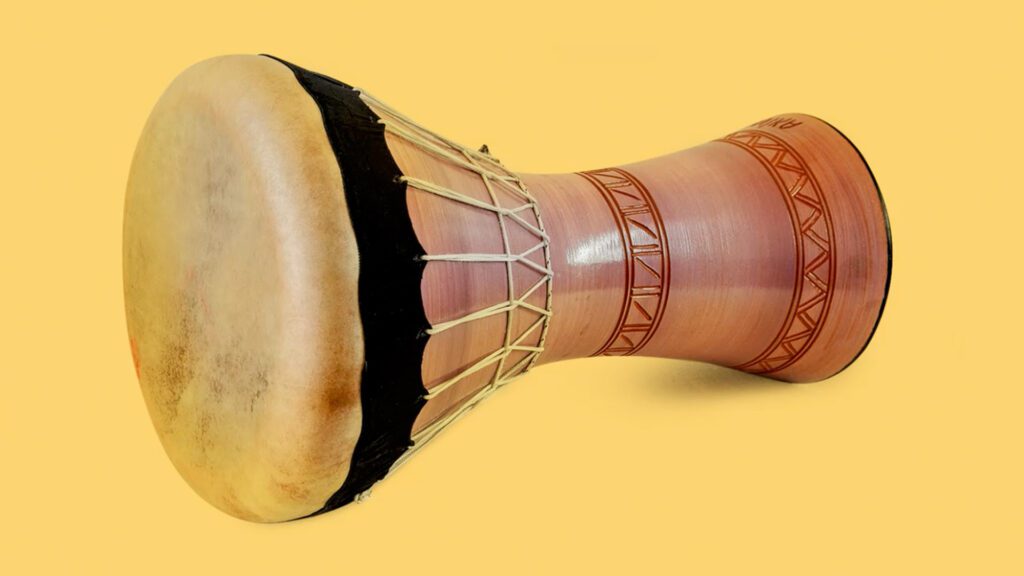The Rhythmic Heartbeat: Exploring the Goblet Drum in Saudi Arabian Music

Introduction
In the intricate tapestry of Saudi Arabian music, one instrument stands out as the rhythmic heartbeat that enlivens melodies, accompanies traditional dances, and preserves the cultural heritage of the region—the goblet drum. Known by various names across the Middle East, including “darbuka” and “tabla,” the goblet drum has a rich history and holds a prominent place in Saudi Arabian musical traditions. In this comprehensive exploration, we delve into the origins, construction, playing techniques, and cultural significance of the goblet drum, unraveling the layers of its contribution to the musical landscape of Saudi Arabia.
Section 1: Origins and Historical Roots
1.1 Ancient Roots in Mesopotamia
The goblet drum has ancient roots that can be traced back to Mesopotamia, the cradle of civilization. Its evolution across centuries and diverse cultures has shaped its unique characteristics and playing techniques. The earliest depictions of similar drum-like instruments appear in ancient Mesopotamian art, suggesting a longstanding tradition that transcends time and borders.
1.2 Spread across Islamic Civilizations
As Islam spread across the Arabian Peninsula, North Africa, and the Levant, so did the goblet drum. The instrument became an integral part of Islamic musical traditions, adapted to local styles and preferences. Its prevalence in the Arab world and its contribution to diverse musical genres underscore its importance in the cultural and religious contexts of the Islamic world.
Section 2: Construction and Design
2.1 Goblet Drum Anatomy
The goblet drum is characterized by its distinctive goblet-shaped body, narrow neck, and wide drumhead. Traditionally, the body is crafted from clay, metal, or wood, while the drumhead is made from animal skin or synthetic materials. The drumhead is stretched taut over the body and secured with ropes or metal tuning screws, allowing for adjustments to achieve different pitches.
2.2 Decorative Elements
Artistic embellishments and intricate designs often adorn the body of the goblet drum. From hand-painted motifs to inlaid patterns, these decorative elements not only enhance the drum’s visual appeal but also serve as a testament to the craftsmanship and cultural significance of the instrument.
Section 3: Playing Techniques
3.1 Hand Percussion Mastery
Playing the goblet drum requires a high level of hand percussion mastery. The drummer, known as a “darbuka player” or “tabla player,” employs a combination of techniques, including finger rolls, strikes, and slaps, to produce a diverse range of sounds. Each part of the drumhead responds differently to various playing techniques, allowing for the creation of intricate and expressive rhythms.
3.2 Varied Styles and Rhythms
The goblet drum is versatile, adapting to different musical styles and rhythms across Saudi Arabia. Whether accompanying traditional Bedouin melodies, enhancing celebratory dance forms like Ardah, or contributing to the vibrant energy of folk music, the goblet drum exhibits a remarkable range of expression.
Section 4: Cultural Significance
4.1 Bedouin Traditions and Nomadic Life
In Bedouin traditions, where oral storytelling, poetry, and music play crucial roles, the goblet drum holds a special place. It serves as a means of entertainment during communal gatherings, where its rhythmic beats amplify the poetic verses and provide a musical backdrop to tales of nomadic life, historical events, and cultural narratives.
4.2 Ceremonial Celebrations
The goblet drum is an integral component of ceremonial celebrations in Saudi Arabia. Whether marking weddings, religious festivals, or national events, the instrument’s lively rhythms create an atmosphere of joy and unity. Its presence in Ardah performances during national celebrations contributes to the patriotic fervor that characterizes such events.
Section 5: Regional Variations
5.1 Hejazi and Najdi Influences
The goblet drum’s influence extends across the diverse regions of Saudi Arabia, each contributing unique styles and nuances to its playing. In the Hejaz region, including cities like Jeddah and Mecca, the drum is often part of celebratory music with distinct rhythms. In Najd, the central region, the goblet drum accompanies traditional dances and adds depth to folk music.
5.2 Asiri Mountainous Melodies
In the southwestern mountains of Asir, the goblet drum takes on a distinctive role in the region’s folk music. The mountainous landscapes and vibrant local customs influence unique playing styles and rhythms, contributing to the rich musical tapestry of Asir.
Section 6: Evolution and Fusion
6.1 Integration into Contemporary Music
While deeply rooted in tradition, the goblet drum has evolved to find its place in contemporary Saudi Arabian music. Its rhythmic versatility has made it adaptable to various genres, including fusion projects that blend traditional instruments with modern influences. The goblet drum’s ability to bridge the gap between past and present highlights its enduring relevance.
6.2 Collaborations and Global Presence
Internationally, the goblet drum has gained recognition through collaborations and performances by Saudi Arabian musicians. Its global presence has expanded through cultural exchanges, world music festivals, and collaborative projects that showcase the instrument’s unique timbre and rhythmic capabilities.
Section 7: Challenges and Preservation Efforts
7.1 Impact of Modernization
As Saudi Arabia undergoes rapid modernization, traditional musical instruments face the challenge of adapting to changing musical preferences and technological advancements. The goblet drum, with its deep cultural roots, requires efforts to ensure its preservation and continued relevance amidst a rapidly evolving musical landscape.
7.2 Cultural Initiatives and Educational Programs
Government-led cultural initiatives and educational programs play a pivotal role in preserving the goblet drum’s heritage. Institutions and organizations dedicated to the promotion of traditional arts contribute to the transmission of knowledge, skills, and appreciation for the instrument among new generations.
Section 8: Conclusion
In conclusion, the goblet drum stands as a testament to the enduring musical heritage of Saudi Arabia. Its rhythmic beats echo across the vast landscapes of the Arabian Peninsula, connecting communities, celebrating traditions, and weaving together the diverse cultural fabric of the region. As Saudi Arabia embraces the future while cherishing its past, the goblet drum continues to resonate as a symbol of cultural pride—a rhythmic heartbeat that transcends time, inviting both locals and global audiences to experience the vibrant musical traditions of this dynamic and richly textured land.




